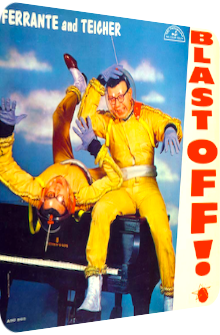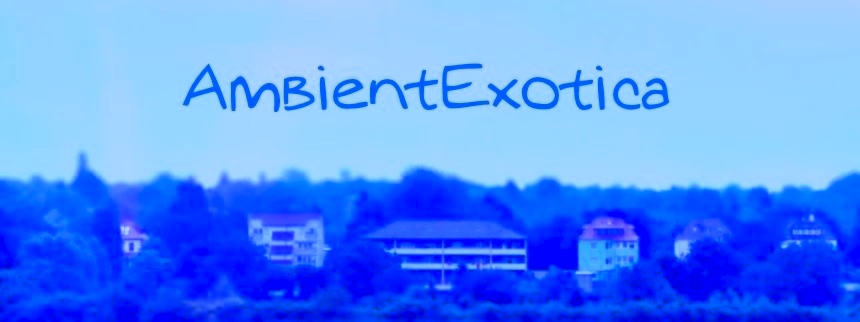
Ferrante & Teicher
Blast Off!
1958
Blast Off! is the third album by the famous duo of pianists and friends since early childhood Arthur Ferrante (1921–2009) and Louis Teicher (1924–2008), released in 1958 on ABC Paramount to critical success. Following the footsteps of their Space-Age magnum opus Soundproof (1955), the pianists generate alienating frequencies and create new tones that have never been witnessed before. Today you turn the knobs on your hardware synthesizer or touch the software buttons. Back then, it meant bolstering the pianos, putting woodblocks between the keys or coating them in styrofoam.
The result, I have to admit, has lost quite a bit of its original spine-tingling creepiness (or magic), but there are still melodies aplenty to distill. Four unique cuts and eight renditions make it to the LP, all of them quirky and mischievous, but many contain a core of soothingness and benignancy as well. Before Ferrante & Teicher became a commodity – no offense intended, the same happened to the Exotica grandmasters as well – and delivered multitudinous albums like clockwork to various topics, their music was groundbreaking in the textural sense, and this LP shows it. These guys occasionally overdo it, testing the very limits and boundaries of their sound waves as well as their contemporaries’ reactions, but then again, Blast Off! is strikingly harmonious on the other side, at least from a viewpoint driven by today’s expect(or)ations.
Ferrante & Teicher have a thing for staccato protrusions of the twirling kind, and they tend to be a bit unnerving at times, aggressive even. Not so on the opener I Got Rhythm which retains the cheerful disposition as envisioned by George and Ira Gershwin. Launching with a helical two-note backing piano whose frequency is altered to resemble a moist-cavernous stringed (!) instrument, the main melody sets in almost immediately, awash with light and unequivocal glee. Naturally, the pianists are avantgarde artists even on their Easy Listening-oriented records, so a mild turmoil ensues: the chords become more staggering while maintaining the exhilarative mood range, glockenspiel-oid blips and spiraling Space-Age lasers complement the scenery. A great lift-off. The Merry Widow Waltz by Johann Strauss II is of no lesser excitement, as it encapsulates the morphogenesis of Exotica despite being no exotic tune at all! While glockenspiels and pristine piano tones resemble the gentleness of sunset-oriented tropical tunes, the laid-back piano arrangement surprises with its hiatuses between the notes, allowing room for a highly altered piano resembling brazen stokehold extirpations.
I should use another exclamation mark soon, but I have to hold on, as it is getting ridiculously awesome soon enough, at least texture-wise, in the duo’s own Chopstick Cha Cha, a simulated harpsichord-dulcimer hybrid of crunchy splinters and a great interaction between the artists. They mimic (or mock?) the clumsy performances of piano novices and intersperse them with faux-koto slaps of the Far Eastern kind. Saltatory and pointillistic, the melodies themselves are an affront, but the delightfully wonky and warped Space-Age tones and their natural reverberation are surely not. As if these complements were not enough, a fairground pipe organ finds its way into the scenery near the end.
The Last Time I Saw Paris by Oscar Hammerstein II and Jerome Kern, meanwhile, is a magical effort where form follows function; the instruments’ surfaces are sparkling, the pianos sound almost bog-standard in the given endemics, and even though the duo revs up the tempo in the last third and imposes a zoetrope of martelato movements, this is Easy Listening… viewed through a periscope. While the second unique piece In The Rain enmeshes fabulously hazy piano rain droplets from Saturn with much more earthen and ruddied dulcimer crystals of the Mediterranean kind, Bye Bye Blues by David Bennett, Chauncey Gray, Frederick Hamm and Bert Lown spawns a rumbling base of abyssal two-note oscillations on whose lathering gestalt Space-Age bleeps and bubbles are grafted. Side A is done.
Ralph Blane’s and Hugh Martin’s Love starts side B, as the duo lets ligneous rhythm pianos and polyphonic nuggets tumble in vertiginous heights. The amount of echo is increased on all fronts, and if it weren’t for the gentle harmonies, this tune could have been an eldritch critter. This is yet another Easy Listening artifact at its core, but shredded apart and ameliorated with asbestus. Ferrante & Teicher’s following composition Hurdy Gurdy uses the same trick: a bewitching fairy tale pirouette in the distance is embedded in an intermixture of cauterized wisps, plinking guttersnipes and whatnots. A waltz for humanoids. Whereas Con Conrad’s and Herbert Magidson’s The Continental multiplexes an evening polyphony that is mobbed up by the turbulent oompah coppice whose verdure turns chlorotic next to the hooting train, Harry Brooks’, Andy Razaf’s and Fats Waller’s Ain’t Misbehavin’ is paradoxically rectilineal, with all the vesiculating flecks you might imagine, yet surprisingly streamlined, worshipping the velvet decay as frequently as the equally silkened attack of each key.
‘S Wonderful is the second song coming from the Gershwin Bros.’ feathers and proves to be yet another seesaw serenade, comprising of the famous (and unharmed!) three-to-four-note motif on the glockenspiel which is then injected into dragonfly flaps. Soothing as it is, the pianists add caffeine as an adjuvant; and Busman’s Holiday does so as well. The duo’s fourth song and finale to the album adds scourging glissandos, protuberances of madness, aqueous-cavernous bubbles and a woodpecker staccato that causes tachycardia… at best. Bus drivers have a hard job, and once they are suspended from duty, their crazy experiences ring through, never letting them contemplate in piece. This infernal mirage of unhealthy glee is the proof of a situation no one has ever demanded.
Blast Off! is a bold title to many people. It implies a “ready, set, go” mentality, covers the gleaming topos called space with its billions of destinations, and emanates a cheerful aggression to, well, break through the boundaries of the ever-limiting narrow mind. Granted, Ferrante & Teicher do not make the biggest of all steps by coming up with exclusively new and shiny material, but four unique cuts in-between eight transmutations is not a bad deal at all! In fact, it is their interpretations of classics which make the pianists’ artifacts so valuable. The duo tries something new in each and every piece, if not in regard to the texture-related tweaks, then all the more so in terms of the mood. They do not want to scare listeners away. Then again, no one should be too assured of his or her knowledge. The opener I Got Rhythm shows the hard balance between eminent euphony and harsh (some say snobby) Avantgarde mannerisms of alteration and destruction. The album lives up to its title any day, on each song.
The specific timbres that were created on Ferrante & Teicher’s 50’s material occur time and again, making their achievement seem less impressive as life goes on, but Blast Off! cannot be blamed, as it is one of only a few spawn points of genuinely creative energy. Exotica fans could cautiously investigate, as a few tone sequences mimic insouciance and languor… it’s 1958 after all. They are way better off with Pianos In Paradise (1962) though. Space-Age fans, on the other hand, know Blast Off! album anyway, true, but do they love it? Depends. Soundproof, for instance, is much more alienating and consequent in its frequency-bending focus. If you want a more melodious side in your music, get Blast Off!, as all grownups know, the value of true beauty is only recognized once it is gone… and Ferrante & Teicher do erase just that on this album, albeit in an equilibrated, cheeky way.
Exotica Review 375: Ferrante & Teicher – Blast Off! (1958). Originally published on Sep. 20, 2014 at AmbientExotica.com.
